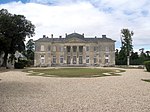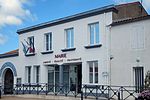Châtelaillon-Plage
Arrondissement of La RochelleAunisCharente-Maritime geography stubsCommunes of Charente-MaritimePages with French IPA

Châtelaillon-Plage (French pronunciation: [ʃatɛlajɔ̃ plaʒ], also [ʃɑtɛlajɔ̃]), commonly known as Châtelaillon, is a commune in the Charente-Maritime department, administrative region of Nouvelle-Aquitaine, France. It is located south of the city of La Rochelle and is also a suburb. It is twinned with Knebworth, England.
Excerpt from the Wikipedia article Châtelaillon-Plage (License: CC BY-SA 3.0, Authors, Images).Châtelaillon-Plage
Rue Pasteur, La Rochelle
Geographical coordinates (GPS) Address Nearby Places Show on map
Geographical coordinates (GPS)
| Latitude | Longitude |
|---|---|
| N 46.0742 ° | E -1.0867 ° |
Address
Rue Pasteur
17340 La Rochelle, Quartier de l'Hippodrôme
Nouvelle-Aquitaine, France
Open on Google Maps









